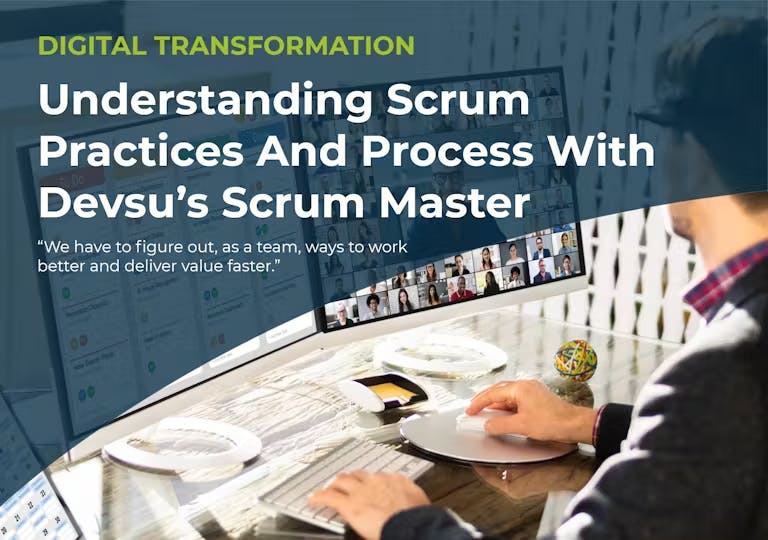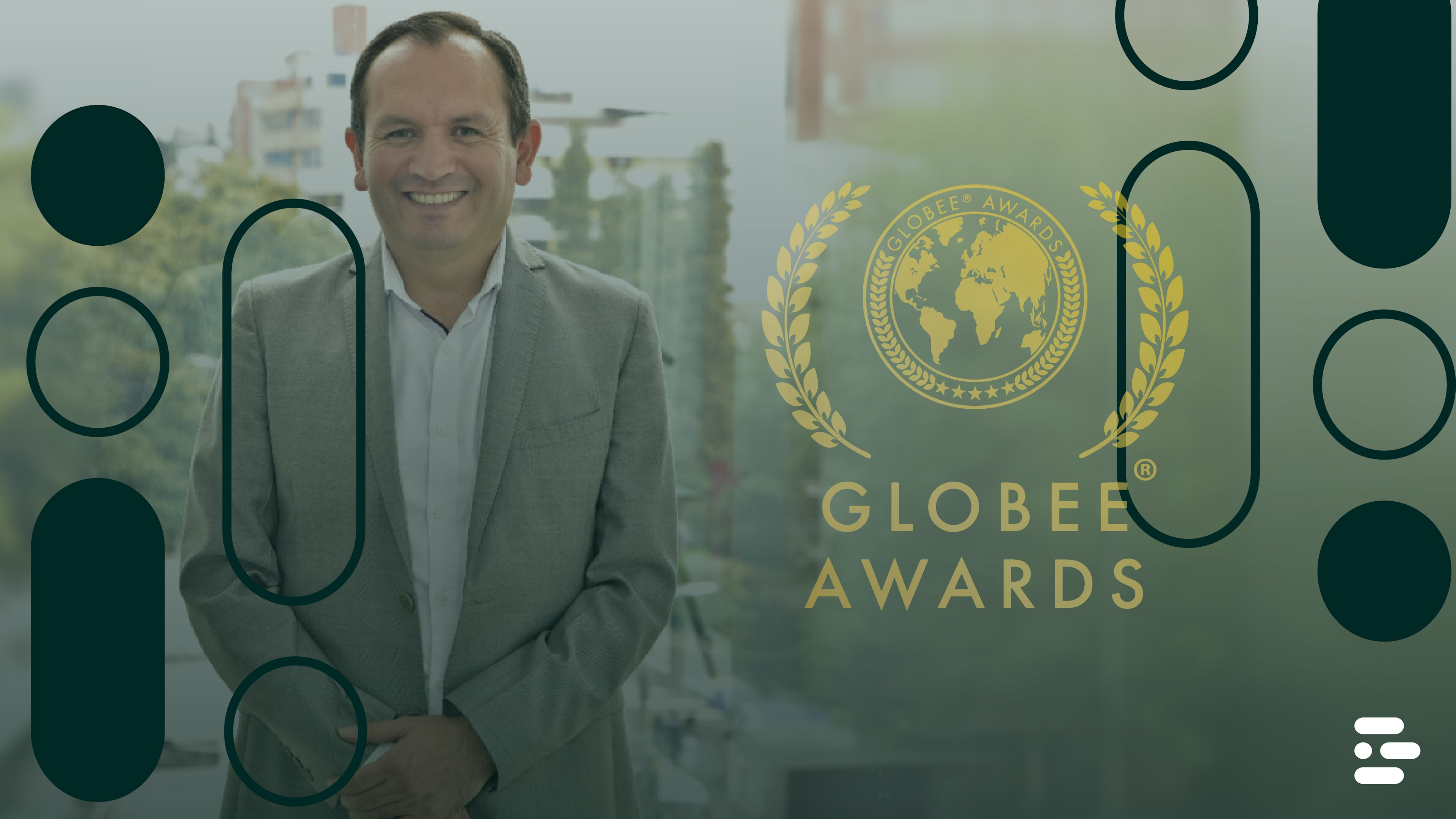Understanding Scrum Practices and Process with Devsu’s Scrum Master


If you’ve been considering process changes for better productivity in your development team or other departments, you’ve presumably heard of Scrum—a lightweight framework, which focuses on offering value through versatile solutions to complicated issues. More casually, Scrum is about getting results as fast as possible for the end-user through solid teamwork.
It’s fitting that Scrum as a term is also used in rugby terminology. In the sport, this describes when the players form a huddle mid-game to discuss tactics, call plays, and move forward together as a team. Scrum practices in development are the same: your team members reflect on successes and failures together to see how they can improve, then get back to project development with a more informed approach.
Read through our Scrum Master interview questions with our certified Devsu Scrum Master, Federico, and get actionable insights into Scrum’s roles, ceremonies, artifacts, and more essentials today.
What’s the Difference Between Agile and Scrum?
“Scrum is part of agile,” Federico explained the basic distinction. Expanding on it, he continued: “Agile is more about methodology and way of thinking, while Scrum is a particular framework that dictates some of the procedures you need to accomplish something.”
Read: Lean vs. Agile: What is the Difference?
Are Scrum and Agile Practices Right for Your Business?
“Every company can be agile because the agile methodology centers more on the culture that the company has and the way people interact with one another, the way departments are built, and the way hierarchies are structured.”
For Scrum, however, Federico said, “You cannot say that Scrum is the one you have to use for every company or every project.”
While it’s accurate that Scrum can be used for any department that’s out to develop an end product—whether that’s digital like a website or physical like building a new office—you want to be certain it’s the right answer for your project. Begin by answering these two questions and decide from there:
- Is your project long or complex in nature?
Because the Scrum framework was designed to make projects more manageable by working in shorter sprints, it doesn’t apply well to quick, simple tasks. For filing records, as an example, you wouldn’t need a user story to outline the requirements. Also, setting story points to estimate the time and effort necessary for filing would be inefficient. But if you’re testing a mobile app or assessing your current work methods, for example, Scrum could be exactly what the situation calls for.
- Can you produce a measurable result in each sprint?
You can set your own sprint length, which is typically 2 to 4 weeks, to create a product increment that is potentially deliverable to the end-user. This gives your team the ability to adjust the product backlog to make sure they reach their goal and meet the expectations of project stakeholders as well as users. If your project has to be 100% ready before making it available for the user, Scrum likely wouldn’t be the right fit for your team.

Why Choose Scrum for Your Software Development?
Determining that you can use Scrum is just one step. Next, let’s discuss why you should implement Scrum for notable project accomplishments that you can easily see and measure during software development.
“There’s always room for improvement, and Scrum in particular says you always have to experiment.” What are the benefits of that, you might ask? Federico had that answer ready. “Being able to experiment lets you fail. If it works, and if it makes what you’re doing better, you stick to it. If not, you discard it and try to find something else.”
More than rigidly empirical project structures, Scrum gives your team the autonomy and room to innovate. This freedom encourages them to do their best work and apply their expertise to the project at hand. When you want to present your business as a thought leader while achieving your goals, nothing is more important than encouraging this growth.
For Federico himself as a Scrum Master, he described this untapped creative potential as what brought him to exploring Scrum in the first place. “I had a business, which was a gym. I was kind of bored with it, and then I switched to software development. I found agile methodologies, particularly Scrum, are always looking to create something new. I’m constantly thinking of and creating new ways of doing things.”
Where Scrum stands out especially is in always seeking this opportunity for growth and innovation by creating a strong foundation for it.
“As a Scrum Master, I have to look at it from the standpoint of the team that I’m working with. We have to figure out, as a team, ways to work better and deliver value faster. We have to make our internal processes as simple as possible.”
By keeping internal procedures simple, it’s even easier to push your limits and reach new heights because the day-to-day work is never at risk. There’s only potential reward in trying something new with a Scrum framework in place. Without the high-stakes penalties for failed ideas sometimes found in traditional project management, your team members will be more confident and willing to try new strategies. Instead of following trends, you’ll be setting them—all while achieving project goals in each sprint.
How Long Does it Take to See Results When You Start Scrum?

“It’s going to depend on the company size, the project you’re working on, the people you work with, and the objective of the project. But in general, when you start implementing Scrum, you can see results very early on. I’m talking maybe 2 months, 3 months.” Discussing when the first signs of improvement will happen, Federico said: “Whenever you decide sprint duration will be, that’s when you’re going to see the first result.”
As for the impact of all this progress, Federico explained, “You can have small results or big results depending on what you’re doing.”
Main Obstacle to Implementing Scrum
“People are afraid of change most of the time, so that would be the biggest fear they have.” Federico gave some context on this, so you can better understand how this apprehension can be a hurdle for Scrum. “Agile requires a change to how the entire organization works, and the way things have been before. Agile structures in general welcome mistakes and errors. They tell you to try new things, and you cannot try new things with a fear of errors.”
Essential Scrum Master Skills to Address This Obstacle
“First, you have to be open-minded. You have to be able to listen. You have to always have empathy.”
“You have to understand that change is not easy for everyone, so you are going to encounter people and organizations that are not going to want change. They’ll say, ‘We want change, but I’m not the one that needs to change.’”
“They’ve been doing things this way for 5, 10, 15 years, then you come in and say ‘Now this is how we’re going to do things.’ You have to be able to motivate and influence these people to start this change in culture.”
Is it Difficult for a Scrum Master to Direct a Project?
At the heart of this question is the purpose of a Scrum Master in project development and management.
“You need to present outcomes, results, and how the team is working. As the Scrum Master, your focus is on the team performance and how the team is actually doing their work. It is not directly to the product or the project itself. That’s the product owner, who reports directly to the superiors.”
But as part of the team effort for any project he’s assigned to, Federico acknowledged that “however, as the Scrum Master, you are responsible for making sure the entire team—including the product owner—has what they need.”
The objective isn’t necessarily to spearhead the project as a lone wolf but to embrace the collaboration of Scrum. “You can work together with whoever you need to work with. You can bring all these people together to work collaboratively in order to present what the company needs.”
Preemptive Training When Starting Scrum
Like any process and cultural change, there are steps you can take to get ahead of any pitfalls or concerns from your team while Scrum is being implemented.
“The first one that I spoke about was fear of change and opposition from people. That one, you start dealing with it first by talking with people who set up these barriers.”
Where do you begin with this discussion?
“You take what they say and run your own analysis. If they’re afraid of something happening, ask why it would happen. How do we prevent it from happening? How do we solve it? Then you go back and present it to this person.”
This may sound like a large undertaking, which could compromise your capacity for other project work and enacting Scrum practices. It’s important to put these two aspects first without brushing aside the valid concerns of your team members. That’s exactly why Federico recommended you “also find what I call quick wins.” To be specific: “Small things that work and that people can see, so they start to change the way they think about change itself.”
Nonetheless, even with that apprehension being acknowledged and worked on as a team, there are going to be growing pains. As Federico put it, “You will encounter that learning curve, and you have to be patient. You can’t expect everyone to understand and click with it. The first time they do it, it’s going to take some time.”
Still, that doesn’t mean you can’t speed it up with a well-thought-out training process to educate your team on the fundamentals of Scrum.
“When you implement the change and everyone’s on board with it, you will encounter issues. For example, people don’t know how to estimate how long something will take them or the effort that it will take.” Federico started with daily meetings in Scrum, typically up to 15 minutes long, as one example of a Scrum-specific situation where your team may need training to prosper. “People may not know exactly what to do on a daily Scrum meeting. That is very normal at the beginning. You are adopting all these things you need to get a handle on. That’s where the Scrum Master comes in.”

How Do Scrum Masters Work Within a Partner Company?
One of the greatest challenges for a Scrum Master is also one of the biggest opportunities: bureaucracy. “As Scrum Master, you have to question everything. You have to question if what you’re doing or what the company’s doing is the best you can do. If there’s room for improvement, you should experiment with that—and have the freedom to do it.”
When there’s an outside person coming into a company, they can provide a fresh perspective for existing leadership to see how red tape could be holding their in-house team back.
“You have to put yourself in the shoes of the other person, who probably doesn’t know about this. They aren’t visualizing the impact that it’s having.”
As a scenario, Federico suggested: “You have a procedure that states five people need to approve something that is going to be implemented. In order to achieve those five approvals, I have to collect signatures and it takes me 3 weeks. You can reduce that to 2 to 3 hours if I just send an email.”
“The best thing you can do is to present the effect this bureaucracy has. You need to gather data, and present why the bureaucracy is not working or why it’s causing you problems. You cannot say, ‘Bureaucracy here is awful.’ and just go with it.”
“You should talk with your manager, HR, or whoever is necessary first. Because in the end, what you’re looking for is, improvement.” The key to unlocking this growth for a partner company lies with a perspective that influences how a Scrum Master interacts with the team. Federico described it by saying, “You have to have a lot of faith in people. The good thing is that eventually, people understand why you do what you do. When they start making little changes and little experiments, some are going to work really well. Some aren’t, then you just go back. People start losing that fear of being wrong. If you’re afraid of being wrong, you won’t innovate.”
Subscribe to our newsletter
Stay informed with the latest insights and trends in the industry
Content
You may also like


